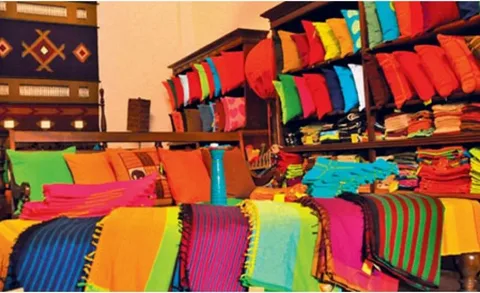The global market size for handloom products is estimated to be US$ 8,190.1 million in 2024. In 2023, the market was valued at US$ 7,697.4 million. It is projected to exhibit a CAGR of 8.30% over the forecast period, with an expected market size of US$ 18,179.1 million by 2034.
Since the pandemic, there has been a considerable push toward sustainable products, including the clothing and garment industry. Consumers all over the world are increasingly seeking products that not only elevate their overall aesthetics but also leave little to no impact on the environment. Handloom products are a perfect choice for these consumers. In countries like India, Sri Lanka, Australia, etc., the significance of handloom products is touching the skies.
Request a Sample Report and Explore New Growth Opportunities Now! https://www.futuremarketinsights.com/reports/sample/rep-gb-18765
The demand for handloom products can also be attributed to the climatic conditions in the Asian and Australian continents. The handloom products, which are usually made from cotton, offer excellent breathability, comfort, and affordability. Besides this, people in these regions have worn handloom products for centuries. This familiarity with the garment has also augmented sales in the last couple of decades.
Government support in countries like India and China to promote indigenous, small-scale enterprises is also one of the main reasons for the expansion of this market. There is also a trend of ethical consumerism, where consumers prioritize products that are produced under fair labor conditions. Handloom products usually adhere to ethical production practices, making them attractive to consumers who value transparency and ethical sourcing.
“The market for handloom products has a lot of room for improvement. There has been little to no technological innovation in this market for centuries. The industry still relies on manual craftsmanship, which limits the production capabilities. Key players in the market must look into these challenges for effective solutions.”, opines an FMI analyst.
Request the Full Report Methodology Now!
https://www.futuremarketinsights.com/request-report-methodology/rep-gb-18765
Key Takeaways from the Market Study
- Handwoven sarees dominate the global handloom product market with a 35.20% share in 2024.
- Cotton products in the handloom product market accounted for 36.70% of the share in 2024.
- The handloom product market in India is predicted to develop a remarkable CAGR of 11.10% through 2034.
- The handloom product market in China is predicted to rise at a whopping 8.40% CAGR through 2034.
- The handloom product market in the United States has the potential to increase at 5.90% CAGR through 2034.
- The Australian handloom product market is predicted to rise by 9.50% CAGR through 2034.
- The handloom product market in Germany is predicted to evolve at a CAGR of 7.60% through 2034.
Competitive Landscape
- FabIndia, Khadi and Village Industries Commission, Mungo Design, Looms of Ladakh, and other established brands play a key role in shaping the handloom product market, collectively holding a substantial market share.
- Key market players are actively investing in research and development initiatives, aiming to enhance the affordability, sustainability, and accessibility of their handloom products.
- Alongside industry giants, the handloom product market features the presence of smaller companies. These entities often bring niche or specialized products to the market.
Recent Developments
- In 2023, the Khadi and Village Industries Commission (KVIC) unveiled a redesigned Khadi India store at the Indian Institute of Technology (IIT) Campus in Delhi to promote handloom products in the national capital region.
- In 2022, FabIndia, a leading player in the handloom product market, introduced its new collection, Svarnim, showcasing the rich cultural diversity of India.Top of Form
Key Market Segmentation
By Product Type:
- Sarees
- Apparel & Accessories
- Bedding & Bath
- Carpet, Mats, & Rugs
- Others
By Material:
- Cotton
- Silk
- Linen
- Wool
By Region:
- North America
- Latin America
- Europe
- Asia Pacific
- The Middle East and Africa
About Future Market Insights, Inc. (FMI)
Future Market Insights, Inc. (ESOMAR certified, recipient of the Stevie Award, and a member of the Greater New York Chamber of Commerce) offers profound insights into the driving factors that are boosting demand in the market. FMI stands as the leading global provider of market intelligence, advisory services, consulting, and events for the Packaging, Food and Beverage, Consumer Technology, Healthcare, Industrial, and Chemicals markets. With a vast team of over 5000 analysts worldwide, FMI provides global, regional, and local expertise on diverse domains and industry trends across more than 110 countries.
Contact Us:
Future Market Insights Inc.
Christiana Corporate, 200 Continental Drive,
Suite 401, Newark, Delaware – 19713, USA
T: +1-845-579-5705
For Sales Enquiries: sales@futuremarketinsights.com
Website: https://www.futuremarketinsights.com
LinkedIn| Twitter| Blogs | YouTube

